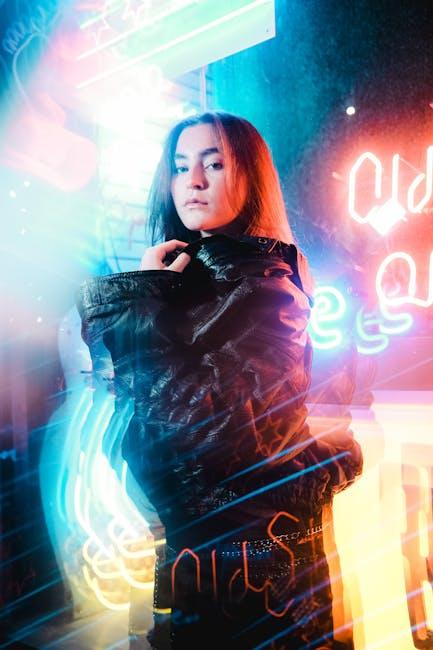In the dim glow of a cinema screen, where stories come alive and emotions dance across the faces of an audience, the magic of film is often conjured not just by narrative or performance, but by the subtle art of lighting. From the stark shadows of film noir to the ethereal glow of a fantasy epic, lighting techniques wield the power to transform a movie’s atmosphere, shaping how we perceive and feel each scene. This article delves into the luminous craft of cinematic lighting, exploring how directors and cinematographers use light and shadow to craft mood, evoke emotion, and transport viewers into worlds both familiar and fantastical. Join us as we illuminate the secrets behind the screen, where every flicker and beam is a brushstroke on the canvas of cinema.
Crafting Shadows and Highlights: The Art of Cinematic Mood
In the realm of filmmaking, lighting is more than just a tool; it’s an alchemical process that shapes the very soul of a scene. By expertly crafting shadows and highlights, cinematographers wield light to sculpt a movie’s emotional landscape. The delicate interplay between darkness and illumination can transform a mundane setting into a vivid tapestry of mood and meaning.
- Chiaroscuro: This classic technique, reminiscent of Renaissance paintings, uses stark contrasts between light and dark to add depth and drama.
- High-Key Lighting: Often employed in comedies and musicals, this approach floods scenes with light, creating an airy, upbeat atmosphere.
- Low-Key Lighting: By embracing shadows, this style evokes mystery and tension, perfect for thrillers and horror films.
Each choice in lighting design, from the angle of a beam to the intensity of a glow, contributes to the film’s narrative, guiding the audience’s emotions and reactions. It’s a silent language, whispering to the subconscious, ensuring every frame resonates with the intended cinematic mood.
Color Temperature: Setting the Emotional Tone
Color temperature in lighting design is a powerful tool that filmmakers use to evoke specific emotions and craft the narrative atmosphere. The warm glow of a sunset, achieved with low color temperatures, can create feelings of comfort, nostalgia, or romance. In contrast, high color temperatures produce a cooler, bluish light, often used to convey sterility, tension, or unease.
- Warm Tones: Perfect for intimate scenes, they envelop the audience in a sense of coziness and connection.
- Cool Tones: Ideal for thrillers or sci-fi, they instill a sense of detachment or foreboding.
By carefully selecting the color temperature, directors can subtly guide viewers’ emotions, ensuring that each scene resonates with the intended mood. This technique transforms ordinary visuals into an evocative storytelling canvas.

Dynamic Movement: Enhancing Storytelling Through Light
In the world of cinema, lighting serves as a silent narrator, guiding the audience’s emotions and focus. By manipulating light, filmmakers can craft dynamic movement within a scene, adding depth and nuance to the storytelling. Consider the use of chiaroscuro, where the contrast between light and shadow highlights conflict and tension, drawing viewers into the characters’ inner turmoil. The play of light can evoke a sense of mystery or danger, as shadows loom large, transforming a mundane setting into a suspenseful tableau.
- Color Temperature: Warm hues can create an inviting, nostalgic atmosphere, while cool tones may suggest isolation or detachment.
- Directional Lighting: A spotlight can isolate a character, emphasizing their importance or solitude.
- Soft Lighting: Diffused light can convey a dreamlike or romantic mood, softening harsh lines and creating an ethereal quality.
By dynamically adjusting these elements, filmmakers wield light not just as a tool, but as an essential character within their narrative tapestry, shaping the audience’s journey through the film.

Practical Tips for Lighting Design: From Concept to Execution
Creating the perfect lighting design for a film involves a blend of artistry and technical skill. Here are some practical tips to ensure your lighting enhances the movie’s atmosphere:
- Understand the Script: Analyze the script to identify key moments where lighting can emphasize mood or emotion. Consider how different scenes can benefit from specific lighting techniques.
- Leverage Natural Light: Whenever possible, incorporate natural light to create a realistic and immersive environment. Use windows, open spaces, and reflectors to enhance the natural ambiance.
- Experiment with Shadows: Shadows can add depth and intrigue. Play with the angles and intensity of light to create dramatic effects that align with the narrative.
- Color Temperature: Adjust the color temperature to evoke specific feelings. Warm tones can convey comfort and nostalgia, while cooler hues might suggest isolation or tension.
- Test and Adapt: Always test your lighting setups before the shoot. Be ready to adapt and make adjustments on set to capture the desired atmosphere.
By following these tips, filmmakers can use lighting to not only illuminate their scenes but also to transform the entire atmosphere, turning each frame into a compelling visual story.

